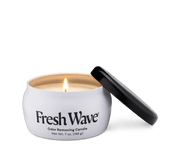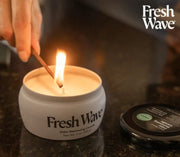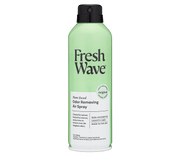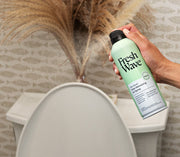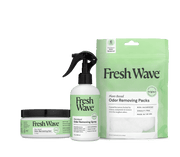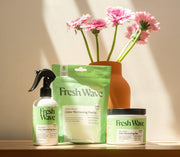How To Remove Burn Stains From Stainless Steel Pans
Odds are, if you’re an avid cooker, you have your favorite, trusted set of pots and pans. Maybe they were gifts from your wedding, a splurge on a special occasion, or a memorable holiday. However you built your collection, kitchenware, especially stainless steel pots and pans, can be expensive. And we don’t blame you for wanting to take good care of them!
But what happens once you have used the cookware a few times (or, maybe even just once) and you have to remove burn stains from the stainless steel? Some home chefs might have their own remedies and secrets to keeping cookware spotless, but at Fresh Wave, we always appreciate a science-based approach. Check out how we recommend caring for and removing burn marks from your stainless steel cookware.
Fresh Wave for the Kitchen
Kitchen accidents, like burning the bottom of your favorite stainless steel cookware, happen all the time. Before you roll up your sleeves and get to scrubbing your pan’s burn stains, fight those common kitchen smells with a natural odor-fighting solution like Fresh Wave.
Fresh Wave has a versatile and effective odor solution for any source. For chefs and avid cooks, the our odor eliminating products can tackle fridge odor, the kitchen trash, smoke, and everything in between. Fight odor proactively in the heart of the home with Fresh Wave so you can get back to taking care of your most prized cookware.
The Science Behind Stainless Steel Cookware
Just as understanding the cause of stainless steel pan burn marks is key to getting rid of them, understanding what makes up stainless steel is key to properly caring for stainless steel cookware.
Stainless steel pans are often known as being all-clad or fully-clad. Although these types of pots or pans are not, ironically, fully made of stainless steel, they do still have stainless steel embedded in them. All-clad stainless steel cookware has layers of materials, most often aluminum sandwiched between stainless steel layers.
A note to keep in mind, some of the more economic stainless steel pots and pans are created through the use of anodized aluminum mixed with the stainless steel layers. Unlike all-clad stainless steel pots and pans, which are bonded with the metals throughout the whole piece, lower-quality stainless steel items sometimes do not have the full item fused with stainless steel and aluminum
How To Remove Burn Stains From Stainless Steel Pans
- Consider your pan’s material
- Use soap and water
- Bicarb soda and water
- Baking soda and lemon juice
Figuring out how to remove burnt stains from your favorite pan might seem like an arduous task if you’re in the middle of rescuing a burned dinner, but don’t worry, all hope is not lost. You just need to breathe, gather the right spot-fighting equipment, and consider a few details about the material of your cookware.
1. Consider Your Pan's Material
Next to copper, aluminum is a great conductor of heat and heat distribution. Because aluminum is able to heat up fast and maintain heat, stainless steel pots and pans (that are aluminum-clad) can be fairly finicky with the mixture of heat, fat (including butter and oil), and food.
Due to the aluminum heating up the stainless steel pan rather fast and sustaining the heat, food can burn, and quickly. On the positive side of having a burnt pan, removing burnt stains on stainless steel is easier than one might expect.
2. Use Soap and Water
The first method to remove burn stains from stainless steel is with good old soap and water and a non-abrasive sponge. Fill up a bowl or your sink with warm water and a bit of dish soap. Agitate the water to distribute the soap and submerge your sponge. Scrub the stainless steel side of your pan to lift as much of the stain as you can. You may need to scrub between soaks before the discoloration fades.
3. Bicarb Soda and Water
Another option for cleaning the burn stains off is to use the dependable method of baking soda. Whether it’s for cleaning kitchen appliances or other home appliances, using a mixture of baking soda and water is one of the most reliable ways to clean… anything!
Simply create a mixture of 3 parts baking soda and 1 part water. For a full pot, Arm and Hammer recommends using 1 cup of baking soda and ⅓ cup of water to clean a full pot bottom. Let the mixture sit for a few hours, then add more baking soda and scrub.
4. Baking Soda and Lemon Juice
While baking soda is a great cleaner and odor-eliminator with a neutral base, lemon juice is going to provide you with an acid base which is key for combating discoloration and stains.
To fight stainless steel pan burn marks with lemon and baking soda, wet the surface of your pan with water and sprinkle the pan liberally with baking soda. Cut a lemon in half and use it to scour the stains. You may see fizzing and that’s okay, it’s just citric acid creating sodium dioxide and sodium citrate when it combines with the base.
Caring for Stainless Steel Cookware
With the knowledge that all-clad stainless steel cookware is made with both aluminum and stainless steel, caring for stainless steel cookware might be easier for the home chef.
The use of steel wool or a harsh scrub brush is not recommended as it will degrade the stainless steel pot or pan more than if a delicate brush or rag is used. If a home chef or cook continually maintains good care for the stainless steel cookware, the pots and pans should last longer than if they were not being paid attention to.
If there is some discoloration on the surface of stainless steel pots or pans, that is a normal byproduct of using the cookware. Because this discoloration is often attributed to using too high of heat when cooking, reach for cast iron steel or carbon steel cookware to give you sparkling stainless steel pans a rest.
Using Fresh Wave Products After You’re Done Caring for Stainless Steel Cookware
Once you have performed your due diligence with removing the burnt stains from your stainless steel cookware, the cleaning is not done. The kitchen will surely have some lingering smokey smells and, after caring for your stainless steel cookware, the distilled white vinegar might have some enduring smell residue in the air. If that is the case, use Fresh Wave products such as an Odor Removing Candle or the Odor Removing Spray.
Fresh Wave products are made with natural ingredients, making them safe to use in the kitchen and the perfect addition to any chef’s arsenal. Select from any of our room sprays, deodorizing gels, candles and more to make your kitchen a place for fresh smells and pre-dinner aromas only.


